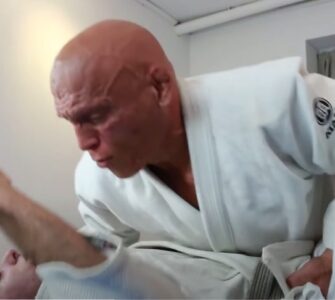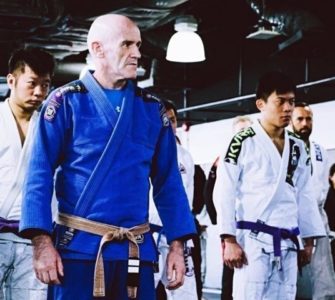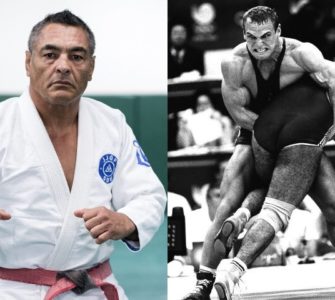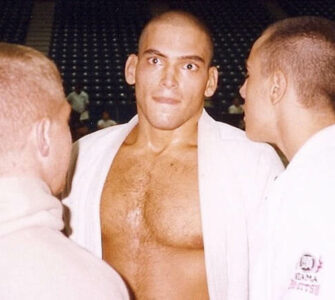The Guys at BJJ.org did a very long and very informative interview with Brandon “Wolverine” Mullins, one of the hardest working and most respected grapplers active in North America today. He’s medalled in a ton of competitions, including judo, freestyle wrestling, and especially gi and no gi Brazilian jiu-jitsu.
Here are the best parts where he talks about strategies, mental preparation and how to prepare for competition.
“Stephan: Talk a little bit about your background, how you got into this crazy sport of rolling around on the ground trying to twist people’s arms to make them say “uncle,” and what led you down this path of combat sports?
Okay; my progression was basically from wrestling, to judo, and then to Brazilian jiu-jitsu.
When I graduated from high school, we moved to Houston and there I met a person named Paul Thomas and he was actually training in Judo and Jiu-Jitsu. Paul was going back and forth from Houston to Brazil to train with my current boss and current jiu-jitsu guru, Prof. Draculino. He told me about Draculino, and even though he was teaching us judo he was always trying to show us what he’d learned in Brazil. I think he was a BJJ blue belt or a purple belt at that time…
And in the next year, in ’99, I moved to Lubbock to go to Texas Tech University and that’s where I met Klay Pittman, a black belt under Carlos Machado. That was the start of my official BBJ training and I went from there.I got my black belt in October 2007 and moved to Brazil shortly after that for about six months. Now it’s 13 years later and still going strong.
Stephan: Do you, or did you ever, get nervous when you compete?
Man, I always got nervous. I still do. And I can remember my very first wrestling match was like a street fight. I literally thought it was like a fight. I went out there just fought as hard as I could, without throwing punches or anything.
But now I’m much more calm. Even though I still get nervous and still feel anxious and still get that adrenaline dump, over the years you learn how to deal with it, just like anybody who’s competed for a long time. You get used to it and you learn how to use it to your advantage, as opposed to letting it get in the way, slow you down, or make you freeze up.
Stephan: Well that puts you apart from a lot of the recreational-level guys who want to train and maybe do a single competition a year, perhaps using that single competition to focus their training to help them get their blue belt or purple belt…
So what advice would you have for them?What advice would you have for recreational players that they can use right away, to help them do that one competition a year?

First of all I would recommend that everybody compete at some level. As long as you train jiu-jitsu, you should compete at least a bit – once a month, once every six months, once a year. I think it’s great to focus your training, like you said.
As far as advice for people compete, there are two things that I want to say…
One is to develop a routine, some people call it a ‘trigger’, that lets you know that it’s time to get in the zone, or that actually puts you in the zone.
I’ll use myself as an example. I like to get to a tournament maybe an hour or two hours early, just to relax and get used to the environment. But then I have a very specific warm-up routine that I do. It’s not very long, it takes me about maybe five to ten minutes, but it gets me into the zone. It’s a very simple yoga routine. I’m sure you’re familiar with it: it’s the ‘sun salutation,’ the most basic kind of yoga stretch routine you can do. I do the sun salutation, coupled with a few other things, and I once do that, I just feel like I’m ready to go.
A lot of times I even do that routine before I train. If I come to an open mat or am just training with a friend then I’ll do that same routine. That way my mind learns that after I do that routine it’s time to train, it’s time to fight, it’s time to go. It just get me mentally focused on what’s about to happen.
A lot of other people do the same type of thing by listening to music. They have a certain playlist that they listen to before they fight. One thing I would recommend is they incorporate that same playlist into their training. Pick out three to five songs – it should be relatively quick because you may not have a lot of time to warm up. It shouldn’t be a 20-song playlist.
Then listening to these songs on your way to the workout, lets you know that it just got real and that now it’s time to get out there and perform, whether it’s training or competition. Having that routine and building that trigger is very, very important for helping you get ready, and also helping you to deal with the anxiety and the emotions and the apprehensiveness that comes with the time before the tournament.
Stephan: What do you listen to? I know you don’t use it as a cue, but what are you listening to on the way to a workout, either to amp you up or to calm you down?
It’s about amping me up to some degree but also making me feel comfortable. I have a pretty eclectic musical taste but in general what I listen to is mostly a mix of punk rock, some regular rock and roll, as well as some rap and some hip-hop mixed in there as well.
When I first get to the tournament, before I’m ready to warm up, that’s when I listen to that music. Both to get relaxed, and then to get amped up. When I’m ready to start the trigger warm-up routine, I normally I turn it off. The routine is what gets me into the right mental state moreso than the music. The music is secondary for me. For other people, it’s more primary.
The second thing is to make sure they stay in a positive state of mind using visualization. And if you think about it, most people already use visualization a lot…
If someone wants to quit their job then they’ll be in their car rehearsing what they’re going to say to their boss, how they’re going to tell their boss off. Or if you’re going to go to a job interview, you’re going to visualize what you’re going to say when they ask a question. Or if you’re going to go on a first date, you’re going to visualize that the jokes and the anecdotes that you’re going to tell to the girl, or how you’re going to make your move, or whatever. You’re going to visualize it. Everybody does it.
And so, what happens in the weeks or months leading up to a tournament, is that you visualize yourself competing. And what used to happen to me is that I would visualize a lot of negative things: going out there and getting submitted, or losing on points, or my jiu-jitsu going haywire on the mat…
What I realized over time by reading sports psychology stuff, which I’m a big fan of, is that no matter what situation you’re visualizing your thinking about, you need to finish it up with a positive thought.
So let’s say you had a bad day at training and now you’re at home, in the shower, or in bed. And now you start thinking “Man, when I go to that tournament I’m going to get armbarred.” Well, you need to continue that thought until you escape that armbar, reverse the position, submit your opponent, and have your hand raised.
Always try to end any sort of thought about the tournament – or training for that matter – on a positive note, no matter how bad it may get in the midst of that visualization session. Make sure you end it on a positive note with the referee raising your hand.
Stephan: So how much of a game plan do you have? I suppose your game plan would change as your level goes up; initially when you’re competing as a blue belt or purple belt, you don’t really know who you’re going to face. But now you’ve got a pretty good idea who you might be facing in the black belt division of the world championship. So how much of a game plan do you have, and how often do you end up following it?
Brandon: I really have two game plans. I have a takedown game plan and I have a guard-pull game plan.
If I’m scouting an opponent, there are two things that I initially look for.
One: will they pull guard or will they go for a takedown?
Two: what’s their stance – right leg forward or left leg forward? That helps me to determine what I’m going to do as well.
But if I have someone who I’ve never seen before and I don’t know either of these things, then I may just go with whatever I feel strongest, or what I’ve been training the most, whether it’s pulling guard or using my takedowns.
I’m a big believer in game plans and I try to follow them as best that I can. Obviously, sometimes things go wrong, but a lot of times things go just like you planned.
Stephan: So if you were going against a guard-puller you’d be more likely to pull guard yourself and try to take them out of their element…
Yeah, if I know a guy is a guard puller, then a lot of times I want to pull guard first and put him in a weaker position. Now, even though he’s on top, I know he’s going to feel uncomfortable.
And against wrestlers I’ll try the same approach just to take them out of their element. I have a lot of confidence in my takedowns, and if this guy is trying to take me down and I feel like I can take him down, then I will, just to take him out of his element, put him on his back, and then I’m going to be able to pass his guard and do whatever…
Stephan: Let’s talk about your preparation for competition. Obviously you’ve got to do sparring, drilling, and conditioning. In my experience that’s how most competitors divide their training. How do you prioritize those aspects of your training, how do you allocate a fixed number of hours in the day to training, and what does a typical day look like for you, say, right now?
 I’m a big believer in getting as much training as possible. I don’t really think that overtraining is real; I think underresting is the problem. You don’t really overtrain; you don’t get enough rest to recover from the training. So I’m in a favorable position because I work at a jiu-jitsu school. We have morning class and we have a night class and we have a break at a middle of the day. And so I’m able to get a lot of rest and naps when my training picks up.
I’m a big believer in getting as much training as possible. I don’t really think that overtraining is real; I think underresting is the problem. You don’t really overtrain; you don’t get enough rest to recover from the training. So I’m in a favorable position because I work at a jiu-jitsu school. We have morning class and we have a night class and we have a break at a middle of the day. And so I’m able to get a lot of rest and naps when my training picks up.
I’m a big fan of drilling and a big fan of positional training. Of course live training is important too, but normally from Monday to Friday I would get at least an hour a day of just straight drilling – just repeating techniques over and over with no resistance.
Most of my live training and sparring comes through the classes that we have at my gym.
And any training outside of class is almost exclusively positional training, like passing the half guard, passing the closed guard, defense against rear mount, defense from side control, attacking from side control. I train in specific positions with specific goals if I reach those goals, then I reset..
Stephan: Okay, so we’ve talked a little bit about drilling and about sparring. How much drilling, sparring, and conditioning are you doing? And also what do you do for conditioning?
I don’t know how I break it down into hours, but my philosophy is that doing additional conditioning work is very important and everybody should do it. And certainly I do it. But you should never skip a jiu-jitsu class or training session to lift weights or run. If there’s an opportunity for you to train jiu-jitsu then that should be your primary goal.
If after practice you still have time and energy, then yes, go to a gym and work out. Get onto the treadmill and run. Get on your bike and pedal yourself to death.
The best way to get into jiu-jitsu shape is to do a lot of jiu-jitsu. I’m a big believer in that; I do a lot of jiu-jitsu. I train in every single class that we have at the school here, and I’m doing additional jiu-jitsu training before class and after class, either drilling or positional training. And then I try to go to the gym a couple of times a week, ride my bike, do kettle bells, and try to run.
But I think people make a mistake when they will skip jiu-jitsu to go to the gym. You need to be working on your technique, and normally the weightlifting gym is always going to be open later than a jiu-jitsu class, so you can go to the weightlifting gym almost any time. There are 24-hour gyms, but you don’t have 24-hour jiu-jitsu…”

















